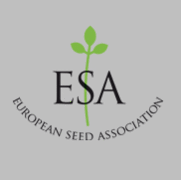ESA European Seed Association
 | |
| Abbreviation | ESA |
|---|---|
| Formation | November 2000 |
| Type | Non-profit trade association |
| Purpose | Representing members in the plant breeding, agriculture, and biotechnology industries |
| Headquarters | Brussels, Belgium |
Region served | European Union, European Economic Area |
President | Nigel Moore |
Secretary General | Garlich von Essen |
| Website | www.euroseeds.org |
The ESA European Seed Association is a trade association for the seed industry in the European Union and the European Economic Area. An umbrella organization of national seed associations and individual seed companies, their members represent all aspects of the European seed industry including research, plant breeding, and the production and marketing of seeds. It was founded in November 2000 and was granted the legal status of international non-profit International Association (AISBL) according to Belgian law in April 2002. Its headquarters are located in Brussels, Belgium.
History
Following increasing inter-organizational cooperation begun in 1998, four separate European seed trade associations were merged into a single organization, the ESA, in 2000. They were COSEMCO (seed trade, founded in 1961), ASSOPOMAC (potato breeders, founded in 1964), AMUFOC (forage seed production, founded in 1970) and COMASSO (plant breeders, founded in 1977).
Functions and scope of activities
According to the ESA's mission statement, it is "the voice of the European seed industry and represents companies and national organisations active in research, breeding, production and marketing of seeds of agricultural, horticultural and ornamental plant species."[1] The ESA serves as a lobby group for all seed industry-related issues in the European Union and European Economic Area and specifically on:
- Seed marketing
- Plant breeding and plant health
- Intellectual property rights such as plant breeders's rights and biotech patents
- Plant and seed health such as phytosanitary rules and seed treatments
- Biodiversity and access to genetic resources
- Land use and food production
- Competitiveness of the EU agri-food chain
It also works on collective problems of its membership such as market access in other countries.
ESA represents the European seed industry via the European institutions (European Commission, European Parliament, Council of Ministers) as well as the EU's Community Plant Variety Office (CPVO) and numerous European and international bodies and organisations. In 2014, the ESA attended a lobby meeting with the American Seed Trade Association (ASTA) and the official US and EU delegations to discuss the industry's interest in the ongoing Transatlantic Trade and Investment Partnership (TTIP) negotiations.[2]
Observer status
The ESA has been granted observer status with the following organizations:
- International Seed Federation (ISF)
- International Union for the Protection of New Varieties of Plants (UPOV)
- Organisation for Economic Co-operation and Development (OECD)
- International Seed Testing Association (ISTA)
- International Plant Protection Convention (IPPC)
- Food and Agricultural Organisation (FAO)
Events
Each year in October, ESA holds its Annual Meeting and the European Seed Trade Meeting which is attended by around 900 participants from industry as well as policy makers, representatives of the European Commission, the EU's Community Plant Variety Office, and international organizations such as UPOV, FAO OECD, the International Seed Testing Association (ISTA).[3]
Membership
European Seed Association (ESA) represents 113 members out of which 37 are national seed associations from EU Members States and the wider Europe. Next to these association members, ESA's membership also comprises 52 individual direct company members, both multi-national as well as specialised small and medium-sized enterprises (SMEs), and 24 associate members from seed related industries, media and academia and from outside of Europe.[4]
ESA presidents
| 2000–2003 | Anthony Keeling, Elsoms Seeds Ltd. (UK) |
| 2003–2006 | Sten Moberg, Svalöf Weibull (Sweden) |
| 2006–2009 | Francois Desprez, Florimond Desprez (France) |
| 2009–2012 | Christoph Amberger, KWS Saat AG (Germany) |
| 2012–2015 | Gerard Backx, HZPC (the Netherlands) |
| 2015–2018 | Nigel Moore, KWS SAAT SE (UK) |
References
- ↑ ESA European Seed Association. ESA Mission Statement
- ↑ "TTIP: released emails show biotech, seeds on the trade talks table". Corporate Europe Observatory. Retrieved August 22, 2015.
- ↑ ESA European Seed Association. ESA Annual Meeting
- ↑ ESA European Seed Association. Members
Further reading
The following contain material on the activities of the ESA:
- Bodiguel, Luc and Cardwell, Michael (2009). The Regulation of Genetically Modified Organisms: Comparative Approaches. Oxford University Press
- Jolly, Adam and Philpott, Jeremy (2012). The Handbook of European Intellectual Property Management. Kogan Page Publishers
- Maggioni, L. and Lipman, E. (2006). Report of the ECPGR Network Coordinating Groups: First Meeting, 29-31 March 2006, Bonn, Germany. Bioversity International